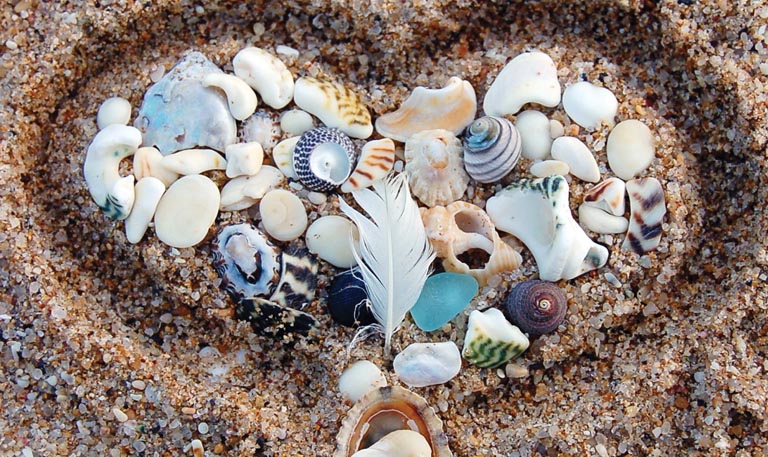I was delighted with the first sock, half full of sand, that my 11-year-old granddaughter, Jen, brought me from her vacation in Mexico. Ten years later, she took time from windsurfing to collect sand from Cuba’s remote Cayo Guillermo.
The grandkids laughed when I started collecting sand samples, but it piqued their curiosity enough that now most are active participants in my obsession. As they grow, they continually bring me samples. Several have starter collections of their own.
John, in his early 20s, took time while vacationing with his sweetie on the Turks & Caicos Islands to collect an envelope of Caribbean sand. “Look what I brought you, Grandpa!” Note he said, “brought,” not bought.
Lucas, 21, spent a month in Iceland and collected three small, thoughtfully labeled bags of sand, carrying them in the bottom of his backpack.
Back home, we pored over maps of Iceland to find Rauðasandur’s famous red sand beach, which gets its color from pulverized scallop shells; Dyrhólaey’s black sand beach (eroded lava); and the remote Thjorsardalur Valley River (mixed glacial sand).
Elliot, 13, helped me get sand from under the Pont du Gard, the ancient Roman aqueduct in southern France. Later we tested the sand with 5 percent acid vinegar. The bubbling sand verified the limestone, typical of that area’s bedrock. Elliot’s vial of sand from the shore of the Gardon River is now a poignant, personal, and inexpensive reminder—a lifetime memory of our visit to that UNESCO World Heritage structure.
While grandson Alex was kite boarding at La Ventana, Baja, I discovered a 100-yard patch of 50 percent black sand that looked like soot. Under close inspection, verified with a magnet, we proved the “soot” to be grains of magnetite, a magnetic ore of iron. Our research discovered a vein of magnetite running through parts of the Baja Peninsula. The black magnetite grains separate from the generic tan quartz presented a most unusual pattern due to difference in specific gravity (density) between quartz (2.6) and magnetite (5.2).
Did I mention science? Geography? Geology? History? Did I mention close inspection of the earth under our feet?
Cindy, 30, emailed, “Grandpa, I’m bringing you sand from my two favorite beaches in New Zealand.”
Collecting sand is so odd that the grandkids had to find out what kind of eccentricity had possessed their grandpa. Once they began to see that sand had so many interesting aspects, they morphed from skeptics to believers to practitioners.
After inspecting and researching each grandchild’s sand gift, I fill two 20 x 150 mm test tubes, cork the top and tape on a source label. I keep one test tube to proudly add to my collection. The second one I send to the gifter along with another tube of some interesting sand sample I have on hand. A simple tube display rack is included along with two empty test tubes which imply “Fill me.”
This is a virtually no-cost, high-reward incidental activity. Old jars work just fine for a few samples. Anything will do. There are no rules.
From collecting, we can move on to looking at sand under a microscope. I confess to having purchased a $250-dollar stereo-optic microscope which provides endless fascination to me, my grandchildren, and friends of all ages. (How much does a new golf driver cost?) Sand under a microscope is extraordinarily interesting and frequently beautiful. Who knew?
My digital microscope camera lets me photograph and share the interesting aspects and beauty of their sands. The International Sand Collectors Society (sandcollectors.com) offers annual Sand Calendars which I gift to my grandchildren.
Sand collection has shown my grandchildren that sand is not just sand. It is often dramatically different from beach to beach. It memorializes special places and times. Sand brings us to look closely, to inspect the earth; to see that not all is what it appears to be; that there is richness underfoot. Sand is now our special connection, a special interest we share.
Who would think? Sand!
Griggs Irving split his working years between being an educator and an entrepreneur. Originally from New England, for the last 35 years he has lived in his “Little Wooden Tent,” one of the last 1901 millworkers’ cottages in the Wallingford neighborhood of Seattle. He delights in associating with his five adult children and 11 grandkids and reveling in Seattle’s cultural bounty.



Discussion1 Comment
Thank you for sharing. I too have a “thing” for sand! My grown boys have no idea and possibly no desire to know…but, oh, those many students in my classrooms! They get it! They can feel and embrace the wonderment! Given time, those grand babies yet to come, will feel the call, the desire to look deeper and below the surface. They will be able to teach their parents what I didn’t!
Thank you a million times!